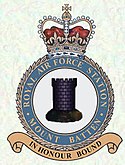RAF Mount Batten
| RAF Mount Batten | |
|---|---|
| Plymouth Sound, Devon, England | |

"In Honour Bound"
|
|
| Coordinates | 50°21′32″N 4°07′48″W / 50.35889°N 4.13000°W |
| Type | Seaplane Station and Flying Boat base |
| Site information | |
| Condition | Closed |
| Site history | |
| In use | 1917-1986 |
| Battles/wars | First World War Second World War |
| Garrison information | |
| Occupants | Royal Naval Air Service Royal Air Force |
RAF Mount Batten was a Royal Air Force station and flying boat base at Mount Batten, a peninsula in Plymouth Sound, Devon. England. Originally a seaplane station opened in 1917 as a Royal Navy Air Service Station Cattewater it became RAF Cattewater in 1918 and in 1928 was renamed RAF Mount Batten. The station motto was In Honour Bound.
Today, little evidence of the RAF base remains apart from several memorials, some aviation-related road names, the main slipway and two impressive Grade II listed F-type aeroplane hangars dating from 1917.
As early as 1913 the sheltered Cattewater in Plymouth Sound was used for seaplane trials and in 1916 plans to open a Royal Navy seaplane station were agreed. In February 1917 RNAS Cattewater was opened. It had a hangar for aircraft, storage and maintenance and a stone pier with a railway track that enabled a steam crane to place the seaplanes in and out of the water. The first aircraft based there were the Short 184 and these were soon followed by other seaplanes. Operational flying was carried out from Cattewater, mainly coastal patrols.
With the formation in April 1918 of the Royal Air Force the station became RAF Cattewater. The station was little used but in 1919 the station became notable with the arrival of the Curtiss NC 4 flying boat making the first aerial crossing of the Atlantic. From 1923 the station was re-built and extended and was re-opened in 1928.
On 1 October 1928, following re-building, the old Cattewater seaplane station was opened as RAF Mount Batten. The main reason for the new station was to provide a base for flying boats to defend south-west England. The first squadron (No. 203 Squadron RAF) became operational with the Supermarine Southampton.
The station also became a base for high-speed air sea rescue launches on which, in the 1930s, was employed Aircraftman Shaw, better known as T. E. Lawrence, who had suggested the change of name.
With the start of the Second World War there was an increase in operational flying from Mount Batten. It was also the target for a number of German air raids including the destruction of one of the hangars including a Short Sunderland on 28 November 1940.
...
Wikipedia

